By 1942-43, the Looney Tunes brand seemed to be in trouble. There were only a dozen cartoons produced under the banner for the season, and they had to resort to producing some of these in Technicolor, which had previously been the exclusive property of the Merrie Melodies. During this season, we get the first title sequences that feature a sharing of the spotlight between the series’ two biggest stars – Porky and Daffy. The series would continue to feature faces of its principal characters for many a season to follow – while the Merrie Melodies would only give “face time” to one character – Bugs.
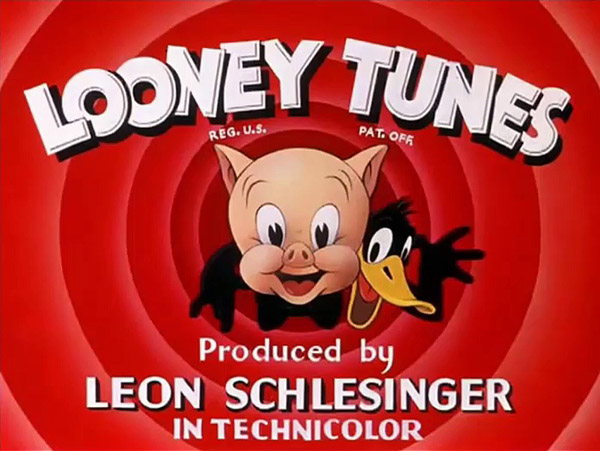
The Impatient Patient (9/5/42) – Daffy is a telegraph boy assigned to deliver a telegram to a certain “Chloe” in the swamp (reference to a 1927 song, subtited “Song of the Swamp”). Daffy also suffers from a chronic case of hiccups. He encounters the mysterious home of Dr. Jerkyl, and doubts he can cure the hiccups – but Jerkyll’s neon sign reassures him “Oh, yes, I can.” The home features a reference to the radio show “Inner Sanctum”, with a front door that squeaks loudly upon opening – only to be followed by a mysterious hand with an oil can to solve the problem. Dr Jerkyll mixes up his formula with such ingredients as moth balls and fountain pen ink, and transforms into Chloe – a man mountain with a weakness for swing music. Daffy mixes some formula himself, transforming Chloe into an adolescent child, and has the last word with more radio references to Fannie Brice’s Baby Snooks and Red Skelton’s “mean widdle kid.” Songs include “Rock a Bye Baby” and “Nagasaki”, both in swing arrangements, and a two-note quote from “Chloe”, which presumably the studio didn’t own. For reference, “Chloe” was recorded in 1927 by the All Star Orchestra on Victor, a group headed by Nat Shilktret, Mac Farley, and Fud Livingston, the latter two considered modernistic arrangers of the time, and also on Victor in a vocal version by the Rounders. Although other labels covered the piece in 1927, Victor continued to claim a virtual monopoly on the piece in later revivals, with Bennie Goodman in 1936, Duke Ellington in 1942, and the infamous and memorable Spike Jones send-up in 1944, with vocal by Red Ingle.
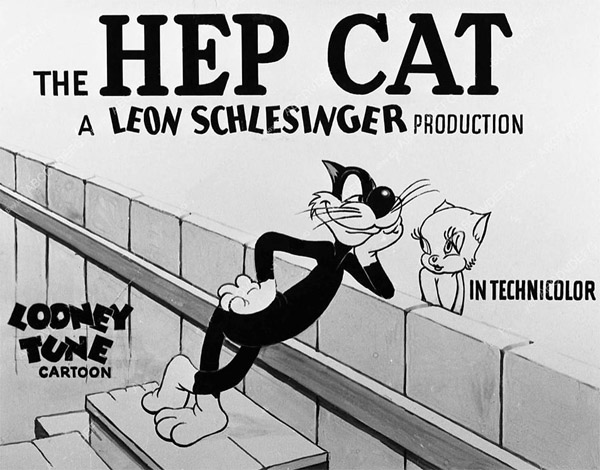
The Hep Cat (10/3/42) – The first Looney Tune to be released in Technicolor. A cat (who some see as a Sylvester prototype, though the voice is without spittle), thinks of himself as the lothario of the backyard fence. He winds up being chased by a dog, while attempting himself to pursue a tantalizing tabby. The dog resorts to puppetry with his own version of the femme fatale. The cat gets tipped off, however, when his paw encounters the dog’s cold nose. “Well! Something new has been added!” Songs: “The Five O’ Clock Whistle”, “Java Jive” (with special lyrics – “I Love the Girls ad the Girls Love Me”), and Mendelssohn’s Spring Song.
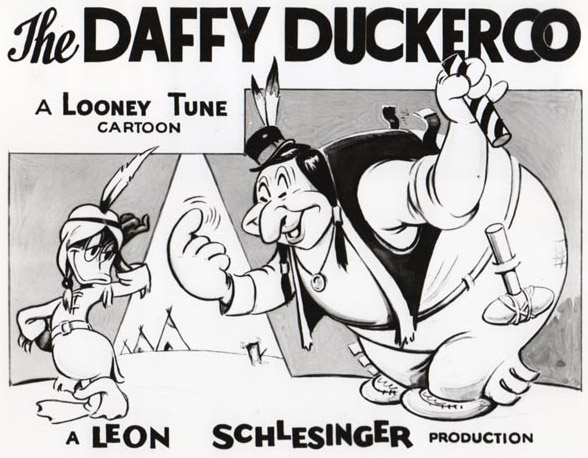
The Daffy Duckaroo (10/24/42) – A Daffy Duck solo Westerm, with Daffy cast as a Hollywood singing cowboy who decides to see what the west is really like. Politically incorrect doings ensue, as Daffy woos an indian princess (who has a Brooklyn accent), but has to dodge her moronic and giant boyfriend through female impersonation. (Daffy must have been taking lessons from Bugs.) Songs: “Hooray for Hollywood”, “California, Here I Come”, and of course “My Little Buckaroo”:
Also on the track, “Always In My Heart”, a song written by Ernesto Lecuona for a Warner Bros. picture of the same name – recorded by Glenn Miller on Bluebird, Kenny Baker on Decca, Orrin Tucker on Columbia, Jimmy Dorseu on Decca, Dick Jurgens on Okeh, Jan Savitt on Victor, Carmen Cavallero on Decca, Phil Green and his Cuban Caballeros on Pan-American, and later by the Philharmonica Trio on Capitol, and across the pond by the New Mayfair Dance Orchestra on HMV, Ambrose on Decca, Cyril Grantham on Regal Zonophone, and Joy Nichols on Regal Zonophone.
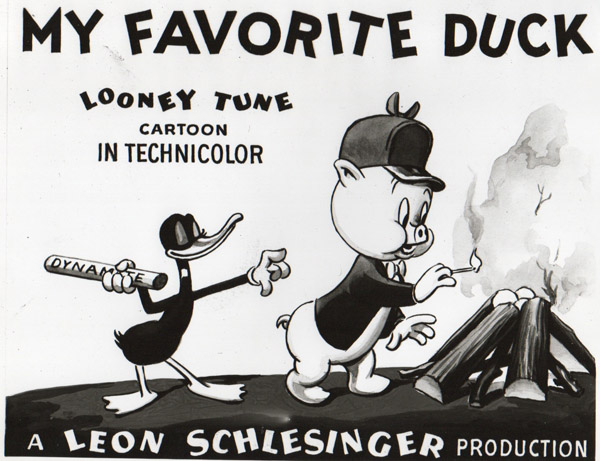
My Favorite Duck (12/5/42) – Recently spotlighted in the “Toons Trip Out” series on Animation Trails. The first Porky and Daffy pairing in Technicolor. Remembered most by me for its running-off-at-the-mouth baby eagle anxious for Daddy to bury Porky after smashing him with a frying pan. Also for the origin of the Jones “film breaking” gag fot a finale. Songs: “Blues in the Night”, and “The Old Time Religion”, an old hymn associated with black congregations, but adopted by many white ones as well. Recorded by the Haydn Quartet on Victor, the Old Southern Sacred Singers on Brunswick, the Tuskegee Institute Singers on Victor, Ernest Thompson on Columbia, the Paramount Jubilee Singers on Paramount, Brother Son Bonds on Decca, and a late “revival” by Phil Harris and his Orchestra on Victor, among others.
But here’s a Glenn Miller swing version of the tune you can’t get out of your head after watching this one – “Moonlight Bay”:
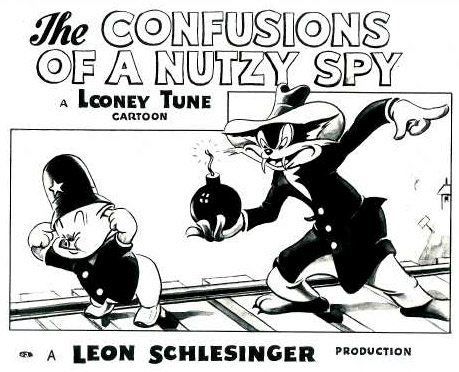
Confusions of a Nutzy Spy (1/23/43), appears to have no popular songs at all, using original score for a tale of policeman Porky’s encounters with a mad Nutzi bomber, “Missing Lynx”. His weapon of choice is the standard cartoon black bomb of ball variety. He of course falls prey to his own weapons at the close, giving a Nazi “Heil” from the clouds above. Title inspired by a 1939 Warner Feature, “Confessions of a Nazi Spy” with Edward G. Robinson (as the good guy).

To Duck or Not To Duck (3/6/43) – Daffy and Elmer attempt to sort out their difference “man to man” in the boxing ring – in a fight that never comes off, thanks to the shortest count by a referee in history. The referee is voiced by Mel in his closest impersonation to the raucous laughter of Tex Avery, and is far from unbiased. (“What a tramp! You can have him!”) Songs: “A Hunting We Will Go”, “William Tell Overture – the Calm”, “Brahms’ Lullaby”, “We Dd It Before”, and a newcomer, “Captains of the Clouds”, the rousing title song of a James Cagney Technicolor war epic, recorded commercially by Dick Powell on Decca, and Mart Kenney and his Orchestra on Bluebird.
Also heard on the track for the first time is a song Stalling really enjoyed, “Why Don’t You Fall In Love In Me” – which was introduced on film by Ozzie Nelson in a 1943 Universal B-musical Honeymoon Lodge. Stalling uses this again in The Wise Quacking Duck, Scrap Happy Daffy and Tweety Pie, among others. Here’s Ozzie and Harriet singing it for the first time on the Red Skelton radio show:
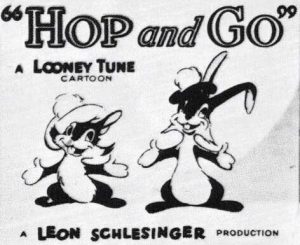 Hop and Go (3/27/43) – Claude Hopper (Pinto Colvig), the self-acclaimed “World’s champeen” hopping kangaroo, is “taken down a peg or two” by two Scottish rabbits who set out to outdo him by trickery. They finally send Claude on a world’s record hop – all the way to Tokyo – carrying explosives, yet! Songs include “Loch Lomond”, “Jingle Bells”, “Captains of the Clouds” and “Singin’ In The Bathtub”.
Hop and Go (3/27/43) – Claude Hopper (Pinto Colvig), the self-acclaimed “World’s champeen” hopping kangaroo, is “taken down a peg or two” by two Scottish rabbits who set out to outdo him by trickery. They finally send Claude on a world’s record hop – all the way to Tokyo – carrying explosives, yet! Songs include “Loch Lomond”, “Jingle Bells”, “Captains of the Clouds” and “Singin’ In The Bathtub”.
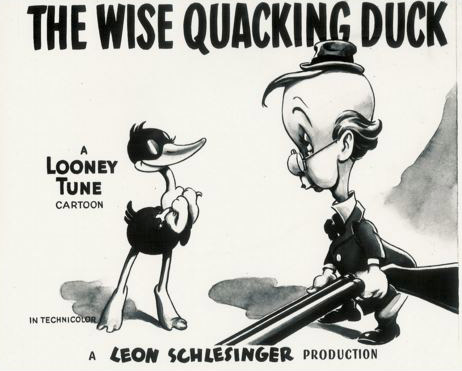
The Wise Quacking Duck (5/1/43) – The henpecked Mr. Meek is hunting Daffy Duck. “If I don’t bring home a duck, Sweetie Puss will cook my goose.” He does get Daffy home, and a good deal of action occurs around the oven (with Daffy performing a feather strip tease). Daffy ultimately ends up basting himself, and complementing Meek with “Now you’re cookin’ with gas!” Songs include “Jeannie With the Light Brown Hair” (w/ special lyeics), “Captains of the Clouds”, and “It Had To Be You” (again accompanying the strip-tease).
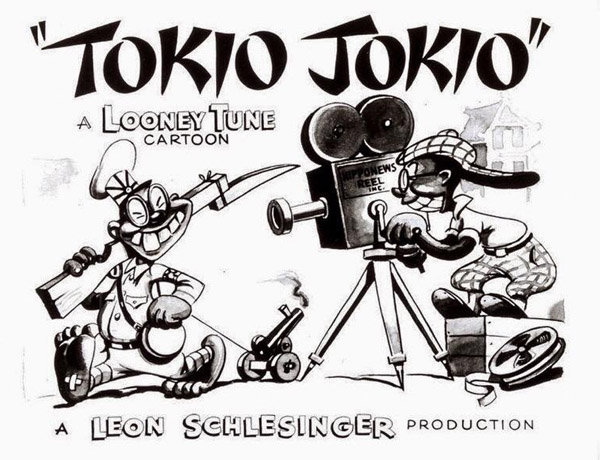
Tokyo Jokio (5/15/43) – Unsubtle wartime cartoon, purporting to be a captured Japanese newsreel. Featuring such obvious gags as the Japanese “sultan of swat” (with fly swatter), and Honorable Aircraft Spotter (painting planes in polka dots). Score includes “Taps” and “Nagasaki”, plus plenty of ersatz kabuki music.
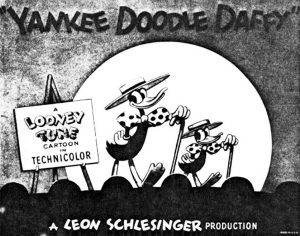 Yankee Doodle Daffy (7/3/43) – Talent agent Porky is about to leave on a trip, while Daffy (perhaps a stage father judging from his demenor of presentation) promotes the next new find in junior duck talent – a straw-hatted duckling named “Sleepy Lagoon”. Lagoon spends nearly the entire cartoon lounging in a chair and eating an all-day sucker, while Daffy puts on a bravura performance to show “what the kid can do” (prompting Lagoon to hold up signs depicting “corn” or “ham”). Sleepy does finally get to sing, but ends his piece in a coughing fit, complaining in lyric about “My Heart”. Songs “You Ought To Be In Pictures”, “Puddin Head Jones”, “I’m Just Wild About Harry”, “Frat”, “Laugh, Clown, Laugh”, “The Gaucho Serenade”, “Willian Tell Overture -Chase” (with special lyrics’), the Can Can dance from Offenbach’s “Gaite Parisienne” (some of the best-selling vintage versions being by the Boston Pops on Victor, and by Efrem Kurtz and the London Philharmonic Orchestra on Columbia) , and Lagoon’s finale, “In the Garden of My Heart”, an art song by Caro Roma and Ernest R. Ball, from the early 1910’s, recorded by Reed Miller on Victor, and Framk C. Stanley and Henry Burr on Zonopjone and on Columbia.
Yankee Doodle Daffy (7/3/43) – Talent agent Porky is about to leave on a trip, while Daffy (perhaps a stage father judging from his demenor of presentation) promotes the next new find in junior duck talent – a straw-hatted duckling named “Sleepy Lagoon”. Lagoon spends nearly the entire cartoon lounging in a chair and eating an all-day sucker, while Daffy puts on a bravura performance to show “what the kid can do” (prompting Lagoon to hold up signs depicting “corn” or “ham”). Sleepy does finally get to sing, but ends his piece in a coughing fit, complaining in lyric about “My Heart”. Songs “You Ought To Be In Pictures”, “Puddin Head Jones”, “I’m Just Wild About Harry”, “Frat”, “Laugh, Clown, Laugh”, “The Gaucho Serenade”, “Willian Tell Overture -Chase” (with special lyrics’), the Can Can dance from Offenbach’s “Gaite Parisienne” (some of the best-selling vintage versions being by the Boston Pops on Victor, and by Efrem Kurtz and the London Philharmonic Orchestra on Columbia) , and Lagoon’s finale, “In the Garden of My Heart”, an art song by Caro Roma and Ernest R. Ball, from the early 1910’s, recorded by Reed Miller on Victor, and Framk C. Stanley and Henry Burr on Zonopjone and on Columbia.
For now, “I’m Just Wild About Harry” from the 1939 Warner Bros. film The Roaring Twenties:
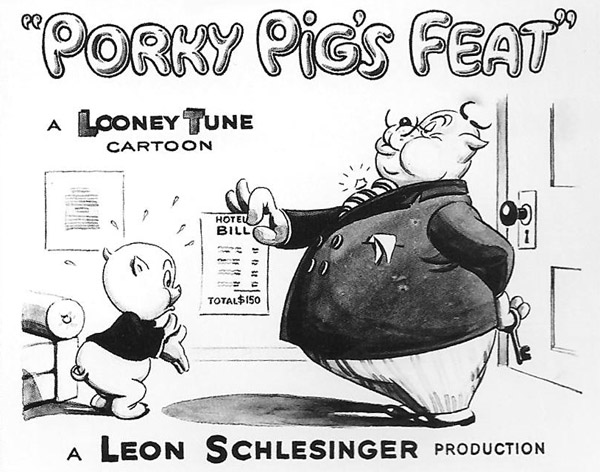
Porky Pig’s Feat (7/17/43) – A riotous Frank Tashlin romp, as Porky and Daffy attempt to outwit the “Palooka manager” of the “Broken Arms” hotel (due to Daffy blowing their room rent while “cashing a check” in a crap game with the hotel elevator operator). The two wind up prisoners until they can come up with the dough – with a surprise cameo for Bugs Bunny, who can offer them no help, as he’s also a prisoner in the next room. Bugs’ first use of the line “What’s up, duck?” Songs “We’re In the Money (The Gold Diggers’ Song)”, “Blues In the Night”, “Oh, you Beautiful Doll”, and “Perpetuum Mobile”, a gallop by Johann Strauss Jr. Most notably recorded ny the Boston Pops on Victor, the Vienna Philharmonic for both HMV and Columbia, and a remarkable vocal version by the Comedian Harmonists, recorded for HMV and issued here on Victor.
The film also marks one of the earliest appearances in a warner cartoon of a composition which has become virtually synonymous with Looney Tunes (though it has in fact appeared in other productions, including Hal Seeger’s “Batfink”): Raymond Scott’s “Powerhouse”. Originally recorded by the Raymond score quintette on Master records. As with many of scott’s compositions, the piece has two distinct themes, both of which seem to have gotten nearly equal usage by Stalling over the years. Here we hear the “A’ theme, suggesting the humming of electricity, punctuated by occasional flashes, used as underscore to the “staircase” sequence, where the manager endlessly tumbles down a multi-floor spiral staircase. In other cartoons, Stalling would use the B theme – a sort of high-powered quick march step, which could be used to equal effect when accompanying the gears meshing of huge contraptive machinery (such as conveyer belts in Swooner Crooner or Baby Bottleneck), or the entrance of a tough bulldog (as in Early to Bet). Joe Daniels and his Hot Shots in “Drumnastics” would cover the piece for Decca. Shay Torrent would later record it for Mercury. In England (also imported here), where the Scott original was not issued, a big band arrangement of the piece was released by Ambrose and his Orchestra.
Scrap Happy Daffy (8/21/43) – Daffy Duck’s last appearance in black and white, and nearly the studio’s last black and white regular release. (Only one more Looney Tune (Frank Tashlin’s “Puss n/ Booty”) would appear in black and white the next season. Then there were the Snafus and Hooks, which will be covered separately in later articles). Daffy is proud of the pile of junk and scrap he has accumulated. The pile even attracts the attention of Hitler, who sends a goat (“a Volk Wolk in sheep’s clothing”) to devour it. Daffy is inspired to action by the patriotic spirits of his ancestors, and assumes the guise of “Super American” – awakening from a seeming dream to find the Nutzis piled atop his scrap heap. Songs include “Yankee Doodle”, “The Battle Hymn of the Republic”, “America”, and the flag-waving original. “We’re In To Win” in a lengthy production number. Never commercially recorded to my knowledge, Jerry Beck has kindly furnished information that the piece was composed by one Private Morris Orenstein, who apparently coined several other flag-waving ditties. It’s only other known appearance is as underscore in the opening sequence of Bugs Bunny’s “Falling Hare”.
Next Time: Merrie Melodies and more.


 James Parten has overcome a congenital visual disability to be acknowledged as an expert on the early history of recorded sound. He has a Broadcasting Certificate (Radio Option) from Los Angeles Valley College, class of 1999. He has also been a fan of animated cartoons since childhood.
James Parten has overcome a congenital visual disability to be acknowledged as an expert on the early history of recorded sound. He has a Broadcasting Certificate (Radio Option) from Los Angeles Valley College, class of 1999. He has also been a fan of animated cartoons since childhood.












































“Confusions of a Nutzy Spy” does have one popular song, played at the beginning of the cartoon: “Hey, Doc” by Edgar M. Sampson. “Hey, doc! Hey, doc! I wonder what’s wrong with me!” It was recorded by the Ink Spots, Cab Calloway and others. I love it that Stalling scored the melody for solo viola on the low C string!
Also, a passage from Smetana’s “Dance of the Comedians” plays at the end of the cartoon.
Those Moylan sisters are adorable!
For the record (no pun intended) here’s another recording of “Why Don’t You Fall in Love With Me?”, this one sung by Dinah Shore: https://www.youtube.com/watch?v=0vqzMKJSGRY
Also another note, “Tokio Jokio” uses the National Anthem of Japan, fittingly.
In HOP AND GO, the swingin’ tune that plays throughout much of the cartoon is an agricultural wartime composition called “Giddap Mule (We’ve Got to Farm to Win this Fight)” by Leonard W. Ware. There’s only one known recording I know of, from a 1943 Soundie film. (https://www.youtube.com/watch?v=VaBlP88IbBw) It can also be heard in PORKY PIG’S FEAT, with Daffy shaking the dice inside the elevator before he rolls “uh-oh, SNAKE EYES!”
Who’s more cute, the Moylan Sisters or Babymetal? Tough call.
Is it just me, or do Chuck Jones’ lobby cards look like they’ve been rendered by someone who’s never seen an animated cartoon? Whereas the others look like they’ve been created by someone who at least works on the Warners lot?
Wonderful research!
One quick correction: in SCRAP HAPPY DAFFY, the phrase you’ve cited as “a Volk Wolk in sheep’s clothing” is really “a Focke-Wulf in sheep’s clothing,” where the Focke-Wulf was a German fighter plane of the time.
Johnny Williams, drummer for Raymond Scott, was the father of John Williams, the great composer (“Star Wars” and lots of others).
Just a question. Who did the laughing in one of the episodes for looney tunes.
it went something like this:
“Ho Ho Ho Ho Ho ho hoooo, Hee Hee Hee Hee Hee hee Heeee!, Ha Ha Ha Ha Ha Ha ha Haaaa.. OOOOH Oohh Ooooo”
or at least tell me what episode. I believe it involved a laugh track radio or laughing gas. Something that couldn’t be turned off.